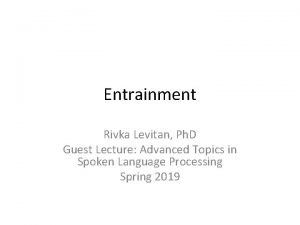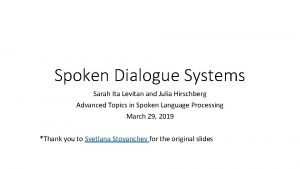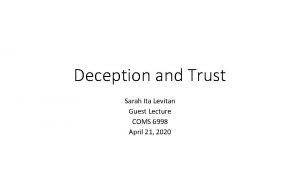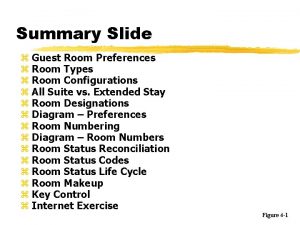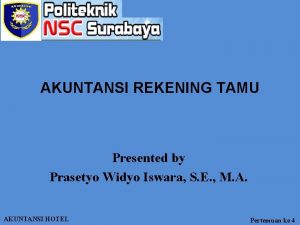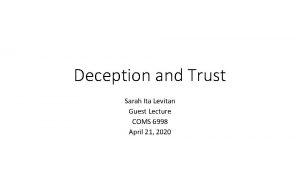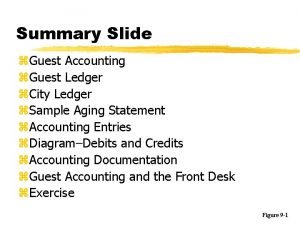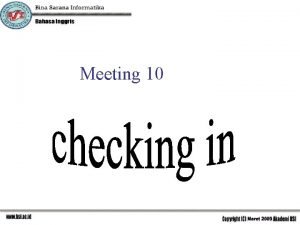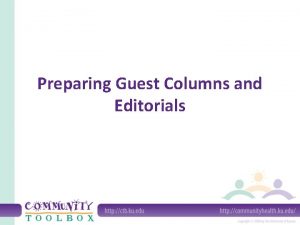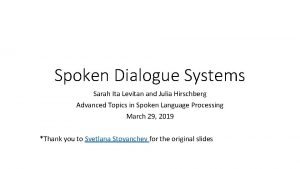Entrainment Rivka Levitan Ph D Guest Lecture Advanced



























- Slides: 27

Entrainment Rivka Levitan, Ph. D Guest Lecture: Advanced Topics in Spoken Language Processing Spring 2019

What is entrainment? 'Are their heads off? ' shouted the Queen. 'Their heads are gone, if it please your Majesty!' the soldiers shouted in reply. 'That's right!' shouted the Queen. 'Can you play croquet? ’ 'Yes!' shouted Alice. 'Come on, then!' roared the Queen, and Alice joined the procession, wondering very much what would happen next. −Alice’s Adventures in Wonderland 2

What is entrainment? 'Jeeves, ' I said, 'you're talking rot. ’ 'Very good, sir. ’ 'Absolute drivel. ’ 'Very good, sir. ’ 'Pure mashed potatoes. ’ 'Very good, sir − I mean, very good, Jeeves, that will be all, ' I said. And I drank a modicum of tea, with a good deal of hauteur. −Very Good, Jeeves 3

Evidence of entrainment • Lexical – – Referring expressions: Brennan & Clark, 1992 High frequency words: Nenkova et al. , 2008 Syntax: Branigan et al. , 2000; Reitter et al. , 2010 Linguistic Style Matching: Niederhoffer & Pennebaker, 2002; Danescuniculescu-mizil et al. , 2011 – To a computer: Brennan, 1996; Stoyanchev & Stent, 2009 • Acoustic-prosodic: – – Response time: Matarazzo & Wiens, 1967; Street, 1984 Intensity, pitch: Natale, 1975; Gregory et al. , 2003; Ward & Litman, 2007 To a computer: Bell et al. , 2003; Coulston et al. , 2002 Intensity, pitch, speaking rate, voice quality, backchannel-inviting cues, pitch contours: Levitan et al. 2011, 2012, 2014, 2015, 2016 4

Entrainment theory • • Communication Accommodation Theory (Giles et al. , 1991) Communication model (Natale, 1975) Perception-behavior link (Chartrand & Bargh, 1999) Interactive Alignment Theory (Pickering & Garrod, 2004) Social Automatic 5

Dialogue quality • • Positive interactions in married couples (Lee et al. , 2010) Score on the Map Task (Reitter and Moore, 2007) Liking, smoother interaction (Chartrand & Bargh, 1999) Social desirability (Natale, 1975) Power (Danescu-Niculescu-Mizil et al. , 2012) Smoother interaction, task success (Nenkova et al. , 2008) Romantic interest (Ireland et al. , 2014) Turn taking, encouraging, trying to be liked (Levitan et al. , 2012) 6

Columbia Games Corpus • • ~9 hours recorded dialogue 12 sessions (~30 minutes each) (each 4 games) 13 participants: 6 female, 7 male Native speakers of Standard American English 7

Units of analysis • Inter-pausal unit (IPU) Pause-free segment of speech from a single speaker. speech <silence> speech • Turn Sequence of speech from one speaker without intervening speech from the other speaker. • Session Complete interaction between two subjects. 8

Units of analysis • Inter-pausal unit (IPU) Pause-free segment of speech from a single speaker. speech <silence> speech IPU IPU • Turn Sequence of speech from one speaker without intervening speech from the other speaker. • Session Complete interaction between two subjects. 9

Features • • Intensity • Shimmer Pitch (F 0) • Noise-to-harmonics ratio (NHR) Syllables per second Jitter 10

Measuring entrainment • Global vs. local • Global: compare average to baseline – other speakers – self in other conversation • Local: compare difference at turn exchanges to baseline – non-adjacent turns 11

Measuring entrainment • Global vs. local • Exact vs. relative • Exact: compare difference between adjacent feature values to baseline • Relative: correlation of adjacent feature values 12

Measuring entrainment • Global vs. local • Exact vs. relative • Converging vs. constant • Global: compare difference in averages over time • Local: correlate adjacent differences with time 13

Results • Global: intensity, speaking rate – Convergence: Pitch max, NHR, speaking rate (reset effect) • Local: intensity, NHR – Convergence: all except jitter and speaking rate; weak • Synchrony: moderate for intensity, none for speaking rate, others weak 14

Variation across speakers

Variations across speakers Some speakers don’t entrain at all Some entrain only positively Some entrain only negatively Some entrain positively for some features, negatively for others • This variation is not explained by gender, native language, or conversational role • •

Implementing entrainment 17

Performance 18

Errors • Feature extraction – Sanity checks • SSML compliance • TTS output quality “What ho!" I said. "What ho!" said Motty. "What ho! What ho!" After that it seemed rather difficult to go on with the conversation. ― P. G. Wodehouse, My Man Jeeves 19

Do users prefer an entraining system? 20

Do users prefer an entraining system? 21

Do users prefer an entraining system? 22

Do users prefer an entraining system? • • • 19 participants: 9 female, 10 male; ages 20— 35 Each session: ~45 user turns, entraining + control turns ~ 9 minutes Acoustic-prosodic features extracted by Praat Advice logged 23

Do users prefer an entraining system? Trust “Who gave better advice? ” ✗ Implicit trust scores ✓ Liking “Which advisor did you like better? ” ✓ Voice “Whose voice did you like better? ” ✗ 24

Do users prefer an entraining system? 25

What we don’t know • How much? (effect size) • Significance of different kinds of entrainment (feature, measure) • Influence of speaker traits/identity • Influence of dialogue context

Collaborators • Andreas Weise (CUNY Graduate Center) • Julia Hirschberg (Columbia University) • Stefan Benus (Constantine the Philosopher University) • Agustin Gravano (Universidad de Buenos Aires) • Sarah Ita Levitan (Columbia University) • Shirley Xia (Jiangsu Normal University)
 Rivka levitan
Rivka levitan Sarah ita levitan
Sarah ita levitan Bazant
Bazant Sarah ita levitan
Sarah ita levitan Lois levitan
Lois levitan Entrainment zone
Entrainment zone Jet mixing venturi mask
Jet mixing venturi mask Pathophysiology of atelectasis
Pathophysiology of atelectasis Design and control of concrete mixtures
Design and control of concrete mixtures Admixtures
Admixtures 01:640:244 lecture notes - lecture 15: plat, idah, farad
01:640:244 lecture notes - lecture 15: plat, idah, farad Advanced inorganic chemistry lecture notes
Advanced inorganic chemistry lecture notes Ncsu eduroam
Ncsu eduroam Guest mail adalah
Guest mail adalah Layout of guest room
Layout of guest room Guest room preferences
Guest room preferences Engagement zone utrgv
Engagement zone utrgv Welcome address for webinar sample
Welcome address for webinar sample Guest teacher expectations
Guest teacher expectations Front office accounting
Front office accounting Advocating guest passion
Advocating guest passion Contoh transaksi akuntansi hotel
Contoh transaksi akuntansi hotel Guest inn greece
Guest inn greece Uninvited guest harris burdick
Uninvited guest harris burdick Guest experience cycle
Guest experience cycle What is national consensus
What is national consensus Late charges in front office
Late charges in front office Services delivered by a valet
Services delivered by a valet
